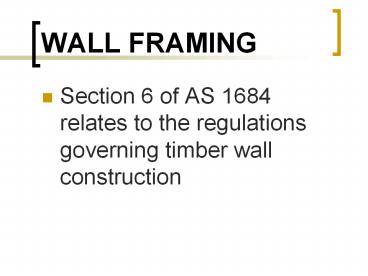WALL FRAMING - PowerPoint PPT Presentation
1 / 22
Title:
WALL FRAMING
Description:
WALL FRAMING Section 6 of AS 1684 relates to the regulations governing timber wall construction Wall Members 6.1.1 Scope This Section sets out the requirements for ... – PowerPoint PPT presentation
Number of Views:174
Avg rating:3.0/5.0
Title: WALL FRAMING
1
WALL FRAMING
- Section 6 of AS 1684 relates to the regulations
governing timber wall construction
2
Wall Members
3
6.1.1 Scope
- This Section sets out the requirements for the
construction of conventional stud-framed walls
and shall be used in conjunction with - Span Tables 7 to 20 (single or upper-storey
construction), - 36 to 48 (lower-storey construction), or
- 51A and 53 (verandahs and posts) of the
Supplements.
4
6.2.1 Studs
- Common studs may be straightened by crippling
with saw cuts and cleats (see Figure 6.2). Up to
20 of common studs, including those in bracing
walls may be crippled. - Studs at the sides of openings and studs
supporting concentration of load shall not be
crippled.
5
6.2.1.1 Straightening of studs (crippling)
6
6.2.1.3 Wall junctions
7
6.2.1.4 Notching, trenching and holes in studs
and plates
- The maximum size and spacing of cuts, holes,
notches, and the like, in studs and plates shall
be in accordance with Figure 6.4 and Table 6.1.
8
Table 6.1 (page 61)
9
notching
FIGURE 6.4 NOTCHING OFWALL STUDS
10
6.2.1.4 Notching, trenching and holes in studs
and plates
- Jamb Studs in external walls and other
loadbearing walls shall not be notched within the
middle half of their height or within the height
of the opening. - A notch up to a maximum of 20 mm in depth is
permissible outside this region at the top and/or
the bottom of the stud (see Figure 6.5).
11
Figure 6.5, page 61
12
6.2.1.5 Nogging
- Wall studs shall have continuous rows of noggings
at 1350 mm maximum centres (see Figure 6.6). - Noggings are not required to be stress graded.
- Nogging thickness shall be a Min 25mm and
suitable for the proper fixing of cladding and
linings.
13
6.2.3 Openings
- Openings shall be framed with jamb studs and
lintels (heads) as shown in Figure 6.9. - Jack studs shall be provided in all cases
between the lintel and the top plate or trimmer.
Jack studs shall be the same size and spacing as
the common studs. - A minimum clearance of 15 mm shall be provided
between the underside of the lintel or lintel
trimmer and the top of the window frame.
14
Changes to the standard
Figure 6.9 (a) pg 64 Spans not exceeding 1200
mm, allows the lintel to be notched into the jamb
stud by ¼ of the stud thickness up to a max of
10mm. for non loadbearing walls
15
Refer to page 64, figure 6.9
1200mm
16
HOWEVER!
- Note v of Table 17 says minimum bearing length to
support lintel must be 35mm. - 6.3.2.3 (in connection with above) any opening
greater than 900 will require two studs. One
full length, and one secondary (see fig 6.9)
17
FIGURE 6.9 OPENINGS
18
Trussed roofs
- Although we are not considering truss roofs in
this subject- it is important that you, as
potential builders realize the following- - Trusses are designed to clear span between
external walls. - If trusses are supported anywhere mid-span,
without being designed accordingly, stresses may
be placed on individual truss components that
they are not designed to take. - The 10mm gap is to allow the trusses to deflect
particularly when / if they are subjected to
their full design load.
19
(No Transcript)
20
Lintels
- Section 6.3.6
- Note adequate bearing required
21
Sill trimmers
- Section 6.3.6.6
22
Verandahs
- Beams, 6.3.7
- Posts, 6.3.8































